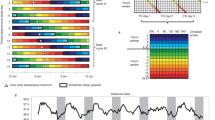Abstract
The fact that every organism possesses an endogenous biological clock can be established when they are made to live in conditions of timelessness. How do human beings perform under such conditions? Human isolation facilities provide such timeless environments where human beings can live comfortably while performing various bodily activities as dictated by their endogenous clock. In this article, I narrate my personal experience in the isolation facility at Madurai Kamaraj University. My stay (on three occasions) has led to the important finding that the menstrual cycle in a human female is not coupled to the sleep-wake cycle. I also describe how such experiments can be useful in the context of shift-working, jet-lag and space studies.
Similar content being viewed by others
Suggested Reading
J Aschoff. Human Orcadian Rhythms: a Multi-oscillator System. Federation Proceedings. 35, 2326–32. 1976.
J Aschoff. Orcadian Rhythms in Man. in: Biological Time Keeping. (Ed) J Brady. Society for Experimental Biology Seminar Series 14. Cambridge University Press. 1982.
M K Chandrashekaran, L Geetha, G Marimuthu, R Subbaraj, P Kumarasamy, M S Ramkumar. The Menstrual Cycle in a Human Female under Social and Temporal Isolation is Not Coupled to the Circadian Rhythm in Sleep-Wakefulness.Curr. Sci. 60, (12) 703–705. 1991.
M K Chandrashekaran, G Marimuthu, R Subbaraj, P Kumarasamy, M S Ramkumar, K Sripathi. Direct Correlation Between the Circadian Sleep-Wakefulness Rhythm and Time Estimation in Humans under Social and Temporal Isolation.J Biosci. 16, 3, 97–101. 1991.
M K Chandrashekaran. Circadian Rhythms, Menstrual Cycles and Time Sense in Humans Under Social Isolation. in: Evolution of Circadian Clock. (Eds) T Hiroshige, K Honma. Hokkaido Univ Press Sapporo. 263–274. 1994.
R T W L Conroy, J N Mills. Human Circadian Rhythms. K & A Churchill, London. 1970.
M Siffre. Six Months Alone in a Cave.National Geographic, March 1975.
R Wever. The Circadian System of Man. Springer Verlag Berlin, Heidelberg, New York. 1979.
Author information
Authors and Affiliations
Rights and permissions
About this article
Cite this article
Geetha, L. Time in a timeless environment. Reson 1, 66–77 (1996). https://doi.org/10.1007/BF02835623
Issue Date:
DOI: https://doi.org/10.1007/BF02835623




